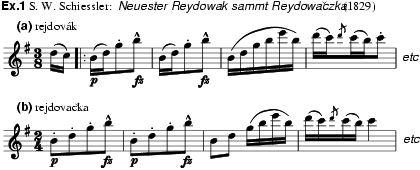
(Ger.; Cz. rejdovák, rejdovačka, from rej: ‘round dance’, ‘whirl’).
A Czech folk dance introduced as a salon dance in Prague in 1829, later spreading beyond Bohemia. In Bohemia it was a double dance: the rejdovák resembled the sousedská (earliest notations have tunes similar to typical minuet and ländler tunes) and was danced at a moderate 3/4 or 3/8; the rejdovačka (a feminine variant of the masculine word rejdovák) provided a second half, often set to a rhythmic variant of the rejdovák tune speeded up to a brisk polka-like 2/4 or 4/8. An early example is S.W. Schiessler's Neuester Reydowak sammt Reydowacžka (1829), which he published the next year in his Carnival anthology (ex.1). Other versions of the coupled rejdovák–rejdovačka were composed by F.K. Landrock, J. Köhler and J.N. Škroup during the height of its popularity in Prague in 1830–32; by 1840 it had disappeared from fashionable Czech balls. Jaroslav Langer claimed in 1834 that the dance was immediately taken up ‘in Hamburg, Vienna, France, England and even in America’ (Nejedlý, p.349); most printed Redowas, however, mostly by German composers, were published later, in the 1840s and 1850s. Examples include several pieces by Anton Wallerstein, Carl Voss's Rosalie, redowa élégante and Ferdinand Beyer's Les belles de New York, 3 polka-rédowas. Abroad the two names were collapsed into the single German ‘Redowa’ and its metrical pecularities variously interpreted, e.g. J.F.F. Burgmüller's two published redowas (both 1846) – La redowa, nouvelle valse Bohemienne and Redowa, polka – suggests the Czech metrical differentiation of the 3/4 rejdovák and the 2/4 rejdovačka continued to exert influence. Later accounts are of a triple-time dance: Barclay Squire described it as ‘like a Mazurka, with the rhythm less strongly marked’; Nettl's description suggests more of a waltz on the same spot. The dance can also be found (as ‘redova’) among the 19th-century mestizo forms in Mexico.

Grove1 (W. Barclay Squire)
MGG1 (‘Redová’; P. Nettl) [incl. further bibliography]
SČHK (‘Rejdovák a rejdovačka’; H. Laudová)
Z. Nejedlý: Bedřich Smetana, iv (Prague, 2/1951), 347–52
JOHN TYRRELL